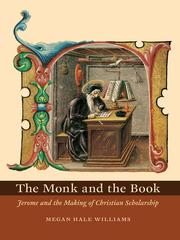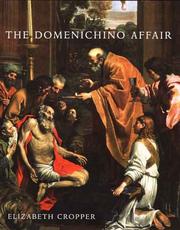| Listing 1 - 4 of 4 |
Sort by
|

ISBN: 1281966827 9786611966829 0226899020 9780226899022 9781281966827 0226899004 9780226899008 Year: 2006 Publisher: Chicago, Ill. University of Chicago Press
Abstract | Keywords | Export | Availability | Bookmark
 Loading...
Loading...Choose an application
- Reference Manager
- EndNote
- RefWorks (Direct export to RefWorks)
In the West, monastic ideals and scholastic pursuits are complementary; monks are popularly imagined copying classics, preserving learning through the Middle Ages, and establishing the first universities. But this dual identity is not without its contradictions. While monasticism emphasizes the virtues of poverty, chastity, and humility, the scholar, by contrast, requires expensive infrastructure-a library, a workplace, and the means of disseminating his work. In The Monk and the Book, Megan Hale Williams argues that Saint Jerome was the first to represent biblical study as a mode of asceticism appropriate for an inhabitant of a Christian monastery, thus pioneering the enduring linkage of monastic identities and institutions with scholarship. Revisiting Jerome with the analytical tools of recent cultural history-including the work of Bourdieu, Foucault, and Roger Chartier-Williams proposes new interpretations that remove obstacles to understanding the life and legacy of the saint. Examining issues such as the construction of Jerome's literary persona, the form and contents of his library, and the intellectual framework of his commentaries, Williams shows that Jerome's textual and exegetical work on the Hebrew scriptures helped to construct a new culture of learning. This fusion of the identities of scholar and monk, Williams shows, continues to reverberate in the culture of the modern university. "[Williams] has written a fascinating study, which provides a series of striking insights into the career of one of the most colorful and influential figures in Christian antiquity. Jerome's Latin Bible would become the foundational text for the intellectual development of the West, providing words for the deepest aspirations and most intensely held convictions of an entire civilization. Williams's book does much to illumine the circumstances in which that fundamental text was produced, and reminds us that great ideas, like great people, have particular origins, and their own complex settings."-Eamon Duffy, New York Review of Books
RELIGION / General. --- Jerome, --- Gerolamo, --- Gérome, --- Gerónimo, --- Girolamo, --- Heronimos, --- Hieronim, --- Hieronymus, Eusebius, --- Hieronymus, --- Hieronymus, Sophronius Eusebius, --- Hieronymus, Stridonensis, --- Ieronim, Stridonskiĭ, --- Iheronimus, --- Jerónimo, --- Jerōnimos, --- 276 =71 HIERONYMUS, SOPHRONIUS EUSEBIUS --- Latijnse patrologie--HIERONYMUS, SOPHRONIUS EUSEBIUS --- Jeronimi, --- Fathers of the church. --- Pères de l'Eglise --- Jerome --- Hieronymus presb. --- Jerome, - Saint, - -419 or 420 --- christian, christianity, faith, belief, religion, religious studies, history, historical, academic, scholarly, research, jerome, sect, monastic, west, western, middle ages, classics, poverty, chastity, morals, values, humility, monastics, asceticism, scholarship, university, education, culture, cultural, bourdieu, foucault, chartier, saint. --- Jérôme (0345?-0420) --- Christianisme et culture --- Ascétisme --- saint --- Savoir et érudition --- Critique et interprétation --- 4e-siècle
Book
ISBN: 352717589X Year: 1988 Publisher: Weinheim VCH
Abstract | Keywords | Export | Availability | Bookmark
 Loading...
Loading...Choose an application
- Reference Manager
- EndNote
- RefWorks (Direct export to RefWorks)
Art, Italian --- Art, Renaissance --- Asceticism in art --- Christian saints in art --- Renaissance art --- Themes, motives --- Jerome, --- Gerolamo, --- Gérome, --- Gerónimo, --- Girolamo, --- Heronimos, --- Hieronim, --- Hieronymus, Eusebius, --- Hieronymus, --- Hieronymus, Sophronius Eusebius, --- Hieronymus, Stridonensis, --- Ieronim, Stridonskiĭ, --- Iheronimus, --- Jerónimo, --- Jerōnimos, --- Art. --- Iconography --- History of civilization --- skulls [skeleton components] --- asceticism --- Renaissance --- scholars --- Jerome --- anno 1300-1399 --- anno 1400-1499 --- anno 1500-1599 --- Italy --- Jeronimi,

ISBN: 0300109148 Year: 2005 Publisher: New Haven, Conn. Yale University Press
Abstract | Keywords | Export | Availability | Bookmark
 Loading...
Loading...Choose an application
- Reference Manager
- EndNote
- RefWorks (Direct export to RefWorks)
Ten years after completing his work 'The Last Communion of Saint Jerome, 'Bolognese painter Domenichino was accused by his rival Giovanni Lanfranco of stealing the idea for the painting from an altarpiece crafted by Lanfranco's teacher, Agostino Carracci. The resulting scandal reverberated through the centuries, drawing responses by artists and critics from Poussin and Malvasia to Fuseli and Delacroix. Why was Domenichino attacked in this way when other related paintings& including Raphael's 'Marriage of the Virgin 'and Perugino's painting of the same subject& aroused no such negative response? In this fast-paced book, Elizabeth Cropper investigates the Domenichino affair and addresses the perennial debate regarding the precise nature of originality and of imitation. She offers close readings of the paintings involved in the story, detailed analysis of attitudes toward imitation, emulation, and plagiarism, and a fascinating discussion of what Domenichino's plight signifies in art history.
Painting --- Aesthetics of art --- Domenichino --- Jerome --- Carracci, Agostino --- Rome --- Imitatie in de kunst --- Imitation dans l'art --- Imitation in art --- Imitation in art. --- Painting, Renaissance --- Domenichino, --- Carracci, Agostino, --- Jerome, --- Authorship. --- Art --- Pictures --- Appropriation (Art) --- Mimesis in art --- Reproduction --- Copying --- Carrache, Augustin, --- Caracci, Agostino, --- Gerolamo, --- Gérome, --- Gerónimo, --- Girolamo, --- Heronimos, --- Hieronim, --- Hieronymus, Eusebius, --- Hieronymus, --- Hieronymus, Sophronius Eusebius, --- Hieronymus, Stridonensis, --- Ieronim, Stridonskiĭ, --- Iheronimus, --- Jerónimo, --- Jerōnimos, --- Domenico, Zampieri --- Authorship --- Painting [Renaissance ] --- Italy --- Jeronimi,
Multi
ISBN: 906569398X 9789065693983 Year: 1988 Volume: jaarg. 50, nr 127 Publisher: Brussel Paleis der Academiën
Abstract | Keywords | Export | Availability | Bookmark
 Loading...
Loading...Choose an application
- Reference Manager
- EndNote
- RefWorks (Direct export to RefWorks)
History as a science --- Epiphanius of Constantia --- Caesarea, of, Eusebius --- anno 1-99 --- Pella --- Epiphane de Salamine, Saint --- Epiphanius van Salamis, Heilige --- Eusebius van Caesarea --- Eusèbe de Césarée --- Histoire ecclésiastique --- Historische bronnen --- Kerkgeschiedenis --- Sources historiques --- Eusebius, --- Epiphanius, --- Church history --- Jews --- History --- 281.2 --- 27 <33> "0070" --- Apostolische Kerk. Judeo-christianisme:--tot einde 1ste eeuw --- Kerkgeschiedenis--Oud-Palestina. Judea--?"0070" --- Theses --- 281.2 Apostolische Kerk. Judeo-christianisme:--tot einde 1ste eeuw --- Apostolic Church --- Christianity --- Church, Apostolic --- Early Christianity --- Early church --- Primitive and early church --- Primitive Christianity --- Fathers of the church --- Great Apostasy (Mormon doctrine) --- Jewish-Roman War, 66-73 --- Roman-Jewish War, 66-73 --- Jerusalem --- Pella of the Decapolis (Extinct city) --- Khirbet Fahil (Extinct city) --- Pehal (Extinct city) --- Pella (Extinct city) --- Pella Decapolitana (Extinct city) --- Jordan --- Ierusalim --- Yerushalayim --- Jeruzalem --- Quds --- Ūrushalīm --- Kuds --- Kouds --- Erusaghēm --- Bayt al-Maqdis --- Jeruzsálem --- Jerusalem (Israel) --- Jerusalem (Palestine) --- ʻIriyat Yerushalayim --- Ierousalēm --- Gerusalemme --- Baladīyat al-Quds --- Baladīyat al-Quds al-ʻArabīyah --- Jerusalem Arab Municipality --- Qods (Jerusalem) --- ירושלים --- القدس --- al-Quds --- قدس --- Church history. --- Antiquities --- Primitive and early church, ca. 30-600 A.D. --- Historiography --- Eusebius of Caesarea --- Иерусалим --- Jerusalén --- Jews - History - Rebellion, 66-73 --- Eglise primitive (ca 30-600) --- Eusebe de cesaree, ecrivain grec chretien, 265?-340 --- Epiphane, saint, 315?-403 --- Critique et interpretation
| Listing 1 - 4 of 4 |
Sort by
|

 Search
Search Feedback
Feedback About UniCat
About UniCat  Help
Help News
News